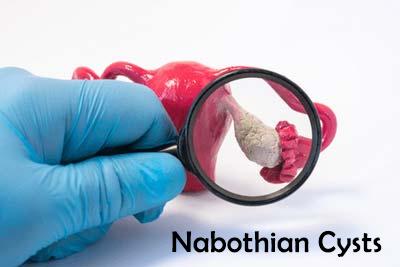
NABOTHIAN CYST
The core classical Ayurvedic scriptures begin with accounts of gods passing down medicinal knowledge to sages and then to human doctors. Ayurvedic treatments have altered and evolved over two millennia. Manual therapies, dietary supplements, lifestyle, herbal medicines, medication, yoga, and purification techniques are all utilized in traditional Indian Ayurvedic medicine. Although ayurvedic techniques are frequently employed to treat nabothian cysts, little comprehensive data on their effectiveness as compared to mainstream care is out there. Here let's examine how Ayurvedic care is critical in curing Nabothian cysts!

AN OVERVIEW ON WHAT ARE NABOTHIAN CYSTS?
Nabothian cysts are a lump crammed with mucus that's secreted by cervical glands of the uterus which are seen on the surface or mouth of the cervix or canalis cervicis uteri. They're very small in size, particularly 1 inch long. they're inclusion cysts (something that has been blocked or collected forms a cyst). Nabothian Cysts are common and benign gynecologic findings in women of reproductive age, generally without clinical significance.
CAUSES OF NABOTHIAN CYST
Cervix is lined with two sorts of cells. The outer part is dry and is the stratified squamous epithelium. The inner part is moist and maybe a columnar epithelium that secretes mucus. Inner columnar epithelial cells protrude out into the mouth of the cervix and become overlapped by the outer squamous epithelium. When this happens, the secretions build up in plugged glands.
This is a traditional condition in pregnant women. Normally, your cervix is hospitable allowing your menstruation fluid to pass from your uterus to your vagina, and for sperm to enter the uterus to your vagina. During pregnancy, the cervix closes to keep the developing baby inside the uterus. After your child is born, thanks to high hormone levels, the columnar epithelium grows over the mucous glands and becomes an erosion, so as soon as, it grows out, it's to get replaced by squamous epithelium that causes inclusion cysts called nabothian cysts.
AYURVEDIC PERSPECTIVE OF NABOTHIAN CYSTS - KARNINI YONI ROGA
The seed capsule of the lotus flower is referred to as Karnini. Karnini Yoni Vyapad may be considered as a little protuberance near the Garbhashaya Dwara that resembles the Padma Karnika or lotus pericarp. An elevated lesion at the Garbhashaya Greeva characterizes the Karnini Yonivyapad. The lesion is claimed to simulate the pericarp of the lotus flower in appearance. Karnini is often compared with cervical erosion. The cervix becomes swollen, congested, and coated with tiny red projections that resemble sprouts in cervical erosion. Due to the presence of small sprouts, the cervix takes on the shape of a small brush. This erosion is usually caused by nabothian cysts, which are small pea-sized smooth nodular structures. When it comes to nabothian cysts, this refers to the lotus pericarp.
If the pregnant woman strains prematurely to expel the fetus, then Vata in reproductive organs gets obstructed by the fetus and successively, Vata is vitiated. Then Rakta (blood) and Kapha together vitiate and further vitiation of Vata occurs. This aggravated Vata causes Karnika (polyp or nodular growth) in her genitalia. This polyp obstructs the course of blood flow, and therefore the ailment is named Karnini.
DIAGNOSING NABOTHIAN CYSTS
Nabothian cysts are often screened and diagnosed during a pelvic examination. It is often seen on a pelvic ultrasound, MRI, or CT scan when watching the cervix. They have a silky appearance and are white or yellow in color. Do not be afraid if you are told you have a nabothian follicle during a vaginal ultrasound exam; their existence is typical. These cysts don't cause pain, discomfort, or other symptoms, and they are in benign condition.
In rare cases, the cysts may become larger and warp the form and size of your cervix, and block the cervix; the corresponding can do a 'Pap test'. If it's severe and needs treatment, they are often removed through excision. In some cases, your doctor may drain fluid from the cyst. They'll recommend this method due to the very minimal blood loss that happens during the procedure.
TREATMENT FOR NABOTHIAN CYSTS
1. Modern Treatment
Small nabothian cysts don't need treatment. A nabothian follicle may range from 2-10 millimeters (mm) in diameter. Nabothian cysts are usually self-resolving. Large nabothian cysts can qualify to 4 centimeters (cm) in size. If an outsized nabothian follicle is causing symptoms, people may have surgery to get rid of it. To remove a nabothian cyst, a clinician may use one of the techniques listed below: Electrocautery - a procedure that includes burning the cyst using a small probe and an electrical current. Cryotherapy - a procedure that includes freezing a cyst with nitrogen.
2. Ayurvedic Treatment
Kushtadi Varti is often considered one of the simplest treatments for Nabothian cysts. Pippali (Piper longum), Kushta (Saussurea lappa), Arka (Calotropis gigantea) buds, and halite are triturated with goat's urine to make Varti (medicated bougie). It's inserted into the vagina which cures Karnini sort of uterine diseases. All the therapeutic measures prescribed for the treatment of diseases caused by Kapha also are beneficial for the cure of this ailment.
Let's explore how Planet Ayurveda can help us in alleviating nabothian cysts!The genuine Planet Ayurveda products have always shown to be the greatest remedy in the event of any ailment. They have consistently provided excellent customer service. They are free of chemicals, fillers, preservatives, yeast, and other additives because they are prepared according to Ayurvedic scriptures. Pradrantak Churna, Chandraprabha Vati Tablets, Kanchnaar Guggul Tablets, and Punarnava Mandur Tablets are part of Planet Ayurveda's 100% natural Anti-ovarian cyst Pack.
Anti-Ovarian Cyst Pack is a collection of female health drugs that aids in the maintenance of hormonal balance. As a result, ailments such as PCOS (Polycystic Ovary Syndrome), PCOD (Polycystic Ovarian Disease), nabothian cysts, and other similar issues can be treated with this pack. There are no adverse effects because all of the medicines are produced with natural and herbal ingredients.
PRODUCT DESCRIPTION
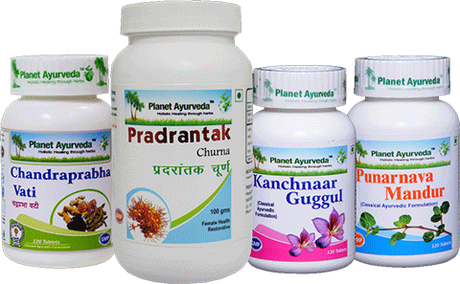

1. Chandraprabha Vati
It's a traditional herbal preparation with Ayurvedic-inspired ingredients. It is particularly effective in painful menstruation, premenstrual syndrome (PMS), irregular menses, uterine fibroids, ovarian, cysts, and leucorrhoea. These tablets contain herbs like Vacha ( Acorus calamus), Mustak ( Cyperus rotundus), Haridra ( Curcuma longa), Vidanga ( Embelia ribes), Giloy ( Tinospora cordifolia), Maricha ( Piper nigrum), Pippali ( Piper longum) & Guggul ( Commiphora mukul), etc that reduce the size of cysts & it's associated symptoms.
Dosage: 2 tablets, twice daily with warm water after meals.
2. Pradrantak Churna
It's a full herbal solution designed to address female health issues. It contains herbs like Lodhra ( Symplocos racemosa), Ashok ( Saraca indica), Udumbu ( Ficus glomerata) & Arjuna ( Terminalia arjuna) that particularly show effective results in painful menstruation, premenstrual syndrome (PMS), irregular menses, uterine fibroids ovarian cysts, and leucorrhoea.
Dosage: 1 teaspoonful, twice daily with warm water after meals.
3. Kanchnaar Guggul
These are traditional herbal tablets that have been utilized for cysts and excess growth in the body since ancient times. Kanchnaar bark ( Bauhinia variegata), Haritaki ( Terminalia chebula), Amalaki ( Emblica officinalis), Bibhitaki ( Terminalia bellerica), Ginger ( Zingiber officinale) & Guggul ( Commiphora mukul), etc that reduce cysts size & remove it out. These tablets are useful in the treatment of uterine fibroids and ovarian cysts.
Dosage: 2 tablets, twice daily with warm water after meals.
4. Punarnava Mandur
It is an effective herbal formulation prepared using the most effective herbs like Punarnava ( Boerhavia diffusa), Pippali ( Piper longum), Amalaki ( Emblica officinalis), Haridra ( Curcuma longa), etc. All these herbs have proven benefits in eliminating toxins from the body and helping get rid of the accumulation of fluid in any part of the body. This mixture is particularly successful in treating ovarian cysts. Aside from that, it also aids in the female's overall well-being.
Dosage: 2 tablets, twice a day with warm water after meals.
As a result, Planet Ayurveda and its products are completely trustworthy and deserving of your trust. Choose wisely and rid yourself of the overwhelming pain of Nabothian cysts. For more details of our products, you can check our website www.planetayurveda.com. For more queries, you can send your queries to our email id [email protected].
DR. Vikram Chauhan, MD - AYURVEDA is an expert ayurvedic doctor based in Chandigarh, India and doing his practice in Mohali, India. He is spreading the knowledge of Ayurveda - Ancient healing treatment, not only in India but also abroad. He is the CEO and Founder of Planet Ayurveda Products, Planet Ayurveda Clinic and Krishna Herbal Company. Write at - [email protected], Contact at - +91-172-521-4030 Websites - www.planetayurveda.com, www.alwaysayurveda.com
View more posts from this author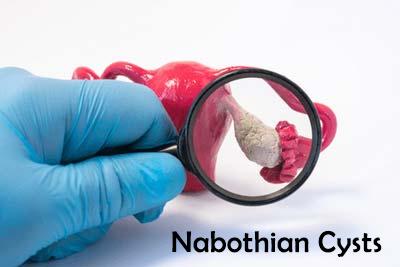
NABOTHIAN CYST
The core classical Ayurvedic scriptures begin with accounts of gods passing down medicinal knowledge to sages and then to human doctors. Ayurvedic treatments have altered and evolved over two millennia. Manual therapies, dietary supplements, lifestyle, herbal medicines, medication, yoga, and purification techniques are all utilized in traditional Indian Ayurvedic medicine. Although ayurvedic techniques are frequently employed to treat nabothian cysts, little comprehensive data on their effectiveness as compared to mainstream care is out there. Here let's examine how Ayurvedic care is critical in curing Nabothian cysts!
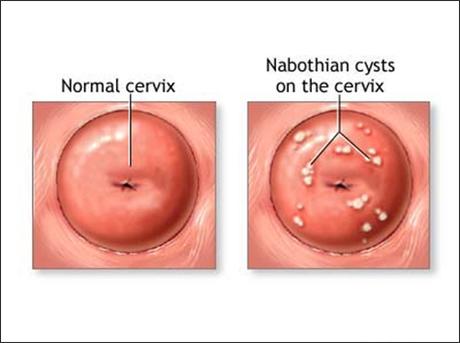
AN OVERVIEW ON WHAT ARE NABOTHIAN CYSTS?
Nabothian cysts are a lump crammed with mucus that's secreted by cervical glands of the uterus which are seen on the surface or mouth of the cervix or canalis cervicis uteri. They're very small in size, particularly 1 inch long. they're inclusion cysts (something that has been blocked or collected forms a cyst). Nabothian Cysts are common and benign gynecologic findings in women of reproductive age, generally without clinical significance.
CAUSES OF NABOTHIAN CYST
Cervix is lined with two sorts of cells. The outer part is dry and is the stratified squamous epithelium. The inner part is moist and maybe a columnar epithelium that secretes mucus. Inner columnar epithelial cells protrude out into the mouth of the cervix and become overlapped by the outer squamous epithelium. When this happens, the secretions build up in plugged glands.
This is a traditional condition in pregnant women. Normally, your cervix is hospitable allowing your menstruation fluid to pass from your uterus to your vagina, and for sperm to enter the uterus to your vagina. During pregnancy, the cervix closes to keep the developing baby inside the uterus. After your child is born, thanks to high hormone levels, the columnar epithelium grows over the mucous glands and becomes an erosion, so as soon as, it grows out, it's to get replaced by squamous epithelium that causes inclusion cysts called nabothian cysts.
AYURVEDIC PERSPECTIVE OF NABOTHIAN CYSTS - KARNINI YONI ROGA
The seed capsule of the lotus flower is referred to as Karnini. Karnini Yoni Vyapad may be considered as a little protuberance near the Garbhashaya Dwara that resembles the Padma Karnika or lotus pericarp. An elevated lesion at the Garbhashaya Greeva characterizes the Karnini Yonivyapad. The lesion is claimed to simulate the pericarp of the lotus flower in appearance. Karnini is often compared with cervical erosion. The cervix becomes swollen, congested, and coated with tiny red projections that resemble sprouts in cervical erosion. Due to the presence of small sprouts, the cervix takes on the shape of a small brush. This erosion is usually caused by nabothian cysts, which are small pea-sized smooth nodular structures. When it comes to nabothian cysts, this refers to the lotus pericarp.
If the pregnant woman strains prematurely to expel the fetus, then Vata in reproductive organs gets obstructed by the fetus and successively, Vata is vitiated. Then Rakta (blood) and Kapha together vitiate and further vitiation of Vata occurs. This aggravated Vata causes Karnika (polyp or nodular growth) in her genitalia. This polyp obstructs the course of blood flow, and therefore the ailment is named Karnini.
DIAGNOSING NABOTHIAN CYSTS
Nabothian cysts are often screened and diagnosed during a pelvic examination. It is often seen on a pelvic ultrasound, MRI, or CT scan when watching the cervix. They have a silky appearance and are white or yellow in color. Do not be afraid if you are told you have a nabothian follicle during a vaginal ultrasound exam; their existence is typical. These cysts don't cause pain, discomfort, or other symptoms, and they are in benign condition.
In rare cases, the cysts may become larger and warp the form and size of your cervix, and block the cervix; the corresponding can do a 'Pap test'. If it's severe and needs treatment, they are often removed through excision. In some cases, your doctor may drain fluid from the cyst. They'll recommend this method due to the very minimal blood loss that happens during the procedure.
TREATMENT FOR NABOTHIAN CYSTS
1. Modern Treatment
Small nabothian cysts don't need treatment. A nabothian follicle may range from 2-10 millimeters (mm) in diameter. Nabothian cysts are usually self-resolving. Large nabothian cysts can qualify to 4 centimeters (cm) in size. If an outsized nabothian follicle is causing symptoms, people may have surgery to get rid of it. To remove a nabothian cyst, a clinician may use one of the techniques listed below: Electrocautery - a procedure that includes burning the cyst using a small probe and an electrical current. Cryotherapy - a procedure that includes freezing a cyst with nitrogen.
2. Ayurvedic Treatment
Kushtadi Varti is often considered one of the simplest treatments for Nabothian cysts. Pippali (Piper longum), Kushta (Saussurea lappa), Arka (Calotropis gigantea) buds, and halite are triturated with goat's urine to make Varti (medicated bougie). It's inserted into the vagina which cures Karnini sort of uterine diseases. All the therapeutic measures prescribed for the treatment of diseases caused by Kapha also are beneficial for the cure of this ailment.
Let's explore how Planet Ayurveda can help us in alleviating nabothian cysts!The genuine Planet Ayurveda products have always shown to be the greatest remedy in the event of any ailment. They have consistently provided excellent customer service. They are free of chemicals, fillers, preservatives, yeast, and other additives because they are prepared according to Ayurvedic scriptures. Pradrantak Churna, Chandraprabha Vati Tablets, Kanchnaar Guggul Tablets, and Punarnava Mandur Tablets are part of Planet Ayurveda's 100% natural Anti-ovarian cyst Pack.
Anti-Ovarian Cyst Pack is a collection of female health drugs that aids in the maintenance of hormonal balance. As a result, ailments such as PCOS (Polycystic Ovary Syndrome), PCOD (Polycystic Ovarian Disease), nabothian cysts, and other similar issues can be treated with this pack. There are no adverse effects because all of the medicines are produced with natural and herbal ingredients.
PRODUCT DESCRIPTION
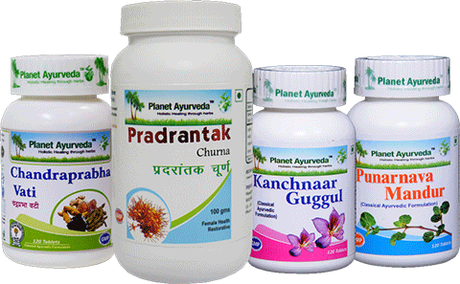

1. Chandraprabha Vati
It's a traditional herbal preparation with Ayurvedic-inspired ingredients. It is particularly effective in painful menstruation, premenstrual syndrome (PMS), irregular menses, uterine fibroids, ovarian, cysts, and leucorrhoea. These tablets contain herbs like Vacha ( Acorus calamus), Mustak ( Cyperus rotundus), Haridra ( Curcuma longa), Vidanga ( Embelia ribes), Giloy ( Tinospora cordifolia), Maricha ( Piper nigrum), Pippali ( Piper longum) & Guggul ( Commiphora mukul), etc that reduce the size of cysts & it's associated symptoms.
Dosage: 2 tablets, twice daily with warm water after meals.
2. Pradrantak Churna
It's a full herbal solution designed to address female health issues. It contains herbs like Lodhra ( Symplocos racemosa), Ashok ( Saraca indica), Udumbu ( Ficus glomerata) & Arjuna ( Terminalia arjuna) that particularly show effective results in painful menstruation, premenstrual syndrome (PMS), irregular menses, uterine fibroids ovarian cysts, and leucorrhoea.
Dosage: 1 teaspoonful, twice daily with warm water after meals.
3. Kanchnaar Guggul
These are traditional herbal tablets that have been utilized for cysts and excess growth in the body since ancient times. Kanchnaar bark ( Bauhinia variegata), Haritaki ( Terminalia chebula), Amalaki ( Emblica officinalis), Bibhitaki ( Terminalia bellerica), Ginger ( Zingiber officinale) & Guggul ( Commiphora mukul), etc that reduce cysts size & remove it out. These tablets are useful in the treatment of uterine fibroids and ovarian cysts.
Dosage: 2 tablets, twice daily with warm water after meals.
4. Punarnava Mandur
It is an effective herbal formulation prepared using the most effective herbs like Punarnava ( Boerhavia diffusa), Pippali ( Piper longum), Amalaki ( Emblica officinalis), Haridra ( Curcuma longa), etc. All these herbs have proven benefits in eliminating toxins from the body and helping get rid of the accumulation of fluid in any part of the body. This mixture is particularly successful in treating ovarian cysts. Aside from that, it also aids in the female's overall well-being.
Dosage: 2 tablets, twice a day with warm water after meals.
As a result, Planet Ayurveda and its products are completely trustworthy and deserving of your trust. Choose wisely and rid yourself of the overwhelming pain of Nabothian cysts. For more details of our products, you can check our website www.planetayurveda.com. For more queries, you can send your queries to our email id [email protected].

